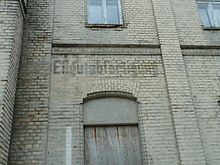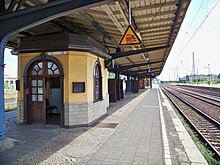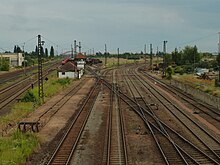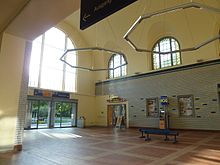Koethen train station
| Koethen | |
|---|---|
|
Station forecourt with reception building
|
|
| Data | |
| Location in the network | Crossing and separation station |
| Design | Through station |
| Platform tracks | 6th |
| abbreviation | LK |
| IBNR | 8010195 |
| Price range | 3 |
| opening | June 9, 1840 |
| Profile on Bahnhof.de | Koethen |
| Architectural data | |
| Architectural style | Classicism (first train station) Neo-Gothic (train stations from 1870) Art Nouveau (current train station) |
| architect |
Conrad Christian Hengst (first station) Karl Jüsgen (current station) |
| location | |
| City / municipality | Koethen |
| country | Saxony-Anhalt |
| Country | Germany |
| Coordinates | 51 ° 45 '8 " N , 11 ° 59' 18" E |
| Railway lines | |
| Railway stations in Saxony-Anhalt | |
The Köthen station in Saxony-Anhalt , which opened in 1840, is considered to be the first railway junction in the German states. An ensemble "unique in Germany" with station buildings from different eras and other buildings is on the list of monuments of the city of Köthen (Anhalt) . The train station has remained a hub and long-distance traffic stop to this day.
location
The station is located east of downtown Köthen (Anhalt) in the Anhalt-Bitterfeld district at 49.8 km of the Magdeburg – Leipzig railway line, which runs roughly in a north-south direction . From the east-northeast, the Dessau – Köthen line reaches the city and ends at the train station. This is where its extension begins, the Köthen – Aschersleben railway line , which runs south of the city towards the west. The branch line to Aken also begins at Köthen station in the northeast .
In the past, both the spelling Köthen and Cöthen was common for town and train station . While the spelling with K was more common when the station was opened, the spelling with C later dominated . Since 1927, the city and train station have uniformly borne the name Köthen .
history
The first train station
As early as 1825 there were plans for a railway connection between Magdeburg and Leipzig, which, however , should initially lead via Bernburg . In 1835 the Magdeburg-Cöthen-Halle-Leipzig Railway Company (MLE) was founded. While the Bernburg Duke Alexander Carl rejected the railway, the Koethen Duke Heinrich supported the construction of the railway, so that the line was led via Koethen. The first train from Magdeburg arrived in Köthen on June 9, 1840, and the extension to Halle was opened on July 22 of the same year .
The Berlin-Sächsische Eisenbahn-Gesellschaft planned a connection from Berlin to the major cities in Saxony in the mid-1830s. However, there were difficulties in obtaining a concession from the Prussian state . After the plans for the construction of the Magdeburg – Leipzig line became known, Köthen emerged as the end point of the line. From there, Magdeburg as well as Halle and Leipzig could be easily reached. The company changed its name to Berlin-Anhaltische Eisenbahn-Gesellschaft (BAE). On September 1, 1840, the line from Dessau (then also written Deßau ) to Köthen went into operation. This made Köthen the first railway junction in the territory of the German Confederation . On September 16, 1841, through traffic to Berlin began. With the construction of direct routes from Berlin to Magdeburg and Halle or Leipzig, the line lost some of its national importance.
In 1846 the Anhalt-Köthen-Bernburg Railway opened the line from Köthen to Bernburg. The MLE took over the management of the trains. In 1863 the Magdeburg-Halberstädter Eisenbahngesellschaft (MHE) bought the Bernburger Bahn, in 1869 the line via Güsten and Aschersleben to Wegeleben was extended, where there was a connection to Halberstadt and Vienenburg .
At the end of the 1860s, the Cöthen train station was also extensively rebuilt. Two new station buildings were built, one for the trains to Magdeburg and Leipzig, one for the trains to Berlin and Halberstadt. In the 1870s, all three railway companies serving Köthen were nationalized. The Prussian State Railways also took over the parts of the Anhalt line.
On May 1, 1890, the line from Köthen to Aken went into operation, the trains departed from Berlin-Halberstadt station.
The central train station
At the latest after the participating railway companies were absorbed into the Prussian State Railways, there was no longer any need for the separate stations. However, a central train station was not built until the 20th century. Construction work began on April 1, 1911. The track subgrade was also raised and the streets crossing it lowered so that level crossings were replaced by underpasses. The construction work dragged on, also due to the First World War, until 1920.
After the First World War, it was planned to electrify the line from Magdeburg to Halle by 1923. Due to a lack of funds, the project was postponed by the Magdeburg Railway Directorate . Preliminary work for the construction of the substation in Köthen had already taken place. It was not until 1933 that electrical operation began on the line and in Köthen station.
During the Second World War, parts of the station were damaged in a bomb attack on Junkers Flugzeug- und Motorenwerke Köthen.
After the Second World War
Some of the track systems, the second tracks on the lines and the systems for electrical operation were dismantled after the end of the war as a reparation payment to the Soviet Union . The narrow-gauge railway to Radegast was completely dismantled.
In 1955, electrical operation was resumed to Halle and Schönebeck , and two years later to Magdeburg.
In 2007 the station was used by around 2000 commuters every day. At the end of the same year, passenger traffic between Köthen and Aken was discontinued.
In 2018, operations will still be controlled by a number of local signal boxes, and the station is equipped with form signals. The construction of a new ESTW ( electronic signal box ) is planned for 2019. The platforms, the station tunnel and all the railway bridges in Köthen are to be renewed from 2022.
In view of the plans, the Association for the Care of the Köthen Railway Heritage has turned to the state parliament with a petition in which the preservation of platform 1, the 100-year-old listed platform equipment with benches and supervisory buildings, a mechanical museum signal box, the further use of the reception building and an alternative solution are required for full closure. The originally planned six-month full closure was then changed so that the regional trains from the direction of Dessau continue to run. In November 2017 it became known that all five platforms would be retained, as well as some of their furniture and roofs.
In autumn 2018, the planning approval documents for the renovation of the station were laid out. A sub-center of an electronic signal box (ESTW) is being built on the east side of the track system. The tracks to the roundhouse are interrupted for the access to the ESTW building. The actual station tracks will only be rebuilt after the ESTW has been commissioned and will be rebuilt in a different arrangement. The platform systems must be renovated as an ensemble in accordance with the preservation of historical monuments.
The actual renovation work is divided into two construction phases. During the first construction phase in 2019, the safety technology was completely replaced, and auxiliary bridges were installed at the Friedrich-Ebert-Straße railway overpass. From June 2019, the Köthen node was almost completely closed for this, only the route from Dessau was initially served to Köthen, for this purpose a makeshift signal box (ESTW-R) was built for around 1.2 million euros. Trains on the Magdeburg - Halle route are diverted via Dessau and Bitterfeld. During the lockout, the Westkopf Köthen was rebuilt and the Stumsdorf – Köthen tracks and other level crossings and railroad flyovers were renewed. Originally, the track system and the new ESTW were supposed to go back into operation in December 2019. Planning errors delayed the work considerably, so that the full closure of the node had to be extended until the end of March 2020, with Deutsche Bahn in the meantime even assuming an extension of the closure until the end of May. The station was put back into operation on April 1, 2020.
Despite its status as a registered cultural monument , the interior of the signal box W1 was expanded and scrapped during the construction work. Deutsche Bahn is also planning to demolish the building of the former substation, which is also a listed building, in order to create space for further construction phases.
The second construction phase includes the actual modernization of the station with track plan adaptation. The separate planning approval procedure required for this is to begin in 2022 and last at least two years, so that construction can only start in 2024 at the earliest. Both construction phases are estimated at at least 120 million euros each.
passenger traffic
In long-distance traffic, the most important of the Koethen touching railway lines was the one to Magdeburg and Halle. Most of the long-distance trains on this route stopped in Koethen. Before the Second World War there were direct connections to Hamburg , Dresden and Vienna, among others . In the 1960s, the connection from Leipzig and Halle via Schwerin to Rostock became particularly important. After German reunification, the traffic flow shifted back to the west.
The route from Dessau via Köthen towards Aschersleben was of less importance. Nevertheless, there were always individual long-distance trains that also stopped in Koethen. In 1939, for example, a pair of express trains ran from Berlin to Wiesbaden and a pair of express trains from Berlin to Frankfurt (Main) via Köthen. After the Second World War there were several express trains daily from Berlin via Köthen to Aschersleben.
In regional traffic, there was a relatively dense range of trains in all directions.
Today the RB 50 from Güsten (already every two hours from Aschersleben) to Dessau run every hour and the RE 30 line from Magdeburg to Halle also runs every hour via Köthen. In long-distance traffic, Köthen has only been served every two hours by intercity trains from Hanover (already coming from Oldenburg / Norddeich Mole ) to Leipzig and on to Dresden since December 13, 2015 .
Investments
The Koethen train station facilities are considered to be "a sequence of historical train station, post office, accommodation and restoration buildings from the private and regional railway era from 1840 to 1917" that is unique in Germany. Four station buildings have been preserved: one from the time the station opened in 1840, two from around 1870 and today's station building from the 1910s. The at least partially preserved other railway structures include the station restoration and the railway post office from 1840 as well as the water tower , a locomotive shed (both from around 1910) and a converter from around 1930 on the site of the former depot east of the platforms . These buildings are also under monument protection like several signal box buildings from the time of the station renovation.
Railway stations from 1840
Location: 51 ° 45 ′ 11.84 ″ N , 11 ° 59 ′ 17.16 ″ E
The Berlin-Anhaltische Eisenbahn-Gesellschaft (BAE) and the Magdeburger-Leipziger Eisenbahn-Gesellschaft (MLE) had separate, practically identical, station buildings facing each other. The Magdeburg-Leipziger Bahnhof was to the west, the Berlin-Anhaltische Bahnhof to the east of the tracks. Both station buildings were designed by the architect Christian Conrad Hengst . Together with the neighboring buildings of the station restoration and the railway post office, also designed by Hengst, they formed an "impressive ensemble that overshadowed many stations in larger cities" ( Manfred Berger ).
The Anhalt-Cöthen-Bernburger Eisenbahn owned a small station building west of the other two for the line opened in 1846. With the new construction of the stations around 1870, the old buildings lost their function. The building of the Berlin-Anhalt Railway was demolished when the station was rebuilt again in 1911.
The building of the Magdeburg-Leipzig railway has been preserved, albeit heavily structurally changed. The current building is a two-storey L-shaped building, the long side of which is oriented towards the street and the short side towards the tracks. There is a dance hall in it.
Railway station restoration and railway post office
Location: 51 ° 45 ′ 12.38 ″ N , 11 ° 59 ′ 14.6 ″ E
The station restoration north of the Magdeburg-Leipziger Bahnhof is the first of its kind in Germany. The large, four-winged building housed the restaurant, pastry shops, a casino and living rooms. While the architecture of the restoration and the station ensemble met with benevolent expressions of opinion, the casino was heavily criticized. A report from 1840 states:
“The train station in Köthen [...] is an extremely magnificent facility, the hospitality building at the same was designed by the Duke like a real palace. It is just a shame that a public casino has been set up in this stately building with state permission, which young people from Magdeburg, Leipzig, Halle, Dessau and other places flock to, especially on Sundays, to try their luck and stimulate themselves to all sorts of desires . "
The casino was closed in 1848 at the instigation of Prussia . Contemporary texts reported: "In Germany the establishment of a new casino at the train station in Koethen when the Magdeburg-Leipzig railway opened, aroused the general displeasure to such an extent that the bank had to be closed again very soon."
From 1878, part of the building was used as a state seminar for teacher training. The house burned down in 1884. The wings on the northeast side (towards the tracks) were not rebuilt. The remaining part of the building was used as a hotel. At first the hotel was called Kaiserhof , today the hotel Stadt Köthen is located in the building .
The rail post office is opposite the restaurant building on the other side of the Kastanienallee. It was built at the same time as the first station buildings and the restoration and was probably also designed by Conrad Christian Hengst. The building had been vacant since the early 1990s and was renovated in 2013. It is used by a hairdresser.
Magdeburg-Leipzig train station
Location: 51 ° 45 ′ 9.83 ″ N , 11 ° 59 ′ 18.42 ″ E
Around 1870 the station facilities were expanded considerably. The railway companies involved could not agree on a common train station. That is why the MLE built its new station in the area of the existing station, the BAE built a separate station 120 meters away, together with the MHE, the building of which was "both a functional and a design counterpart" to that of the Magdeburg station.
The new station building of the Magdeburg-Leipziger Bahnhof was built to the south of the old one. The elongated, two-story, neo-Gothic brick building consists of a central section with eight axes and originally two three-axis side sections with a risalit . Only the northern and central parts of this have been preserved. The southern side section was removed during the construction of today's reception building, which is only separated from the remaining part of the building by a narrow passage. The original gables and the platform roof have also not been preserved. The facades are to be understood with large arched windows. In 1916 the station, like the Berlin-Halberstädter station, was replaced by today's station.
Today the building is unused.
Berlin-Halberstadt train station
Location: 51 ° 45 ′ 5.87 ″ N , 11 ° 59 ′ 13.06 ″ E
The Berlin-Halberstadt train station was also built in 1870/71. It was a joint station of the Berlin-Anhaltische and the Magdeburg-Halberstädter Eisenbahn and got its name from a combination of both company names. In addition to the traffic in the direction of Dessau (Berlin) and Aschersleben - Halberstadt, it was also used for trains to Aken.
The train station is on Georgstrasse, about 120 meters from Magdeburg-Leipziger Bahnhof. The tracks of the Berlin-Halberstädter Bahn were located between the two station buildings. Like the Magdeburg-Leipziger Bahnhof, it is an elongated two-story brick building with large arched windows, but with a risalit in the middle section that also has an ornamental gable. The facade is structured by pilaster strips and ledges . The lettering Berlin-Halberstädter Bahnhof on the city side and Cöthen on the former track side as well as some lettering at the entrances have been preserved.
The building served, among other things, residential purposes until the 1980s, but is now empty. To the south of the reception building were operational facilities of the Berlin-Halberstadt train station. The remains of a locomotive shed can be found on Bahnhofstrasse at the corner of Franzstrasse.
Today's train station
Location: 51 ° 45 ′ 7.96 ″ N , 11 ° 59 ′ 18.35 ″ E (station building)
Location: 51 ° 44 ′ 40.02 ″ N , 11 ° 59 ′ 26.99 ″ E (freight yard)
The station building was built from 1915 to 1917 in the late Art Nouveau style; the architect was Karl Jüsgen . It is dominated by a large reception hall with a gable roof , the architectural decor of which has largely been preserved. This is followed by a single-storey porch; whose structure elements have largely been removed. On the track side there is an elongated two-storey part of the building with a gable roof.
Since the renovation in the 1910s, the tracks in the station area have been elevated above the ground level of the area. The station has an outside platform 1 at the station building and two central platforms with tracks 2/3 and 4/5 respectively. A tunnel connects the station building with the platforms, it can be reached from the building without steps. There is no continuous connection to the east side of the railway station, this area can be reached via the underpass of Friedrich-Ebert-Straße to the north. Via track 5 there is access to a narrow platform with platform track 6. This platform is no longer used for scheduled passenger traffic.
The trains in the direction of Halle and Magdeburg usually run from tracks 4 and 5, which to Bernburg and Dessau from tracks 2 and 3. Track 1 was used until passenger traffic to Aken was discontinued, especially the trains there, from individual passenger trains continue to drive on the track (as of 2013).
There are supervisory buildings and benches on the platforms from the time the station was renovated in the 1910s.
The extensive facilities for freight traffic are located south of the platforms, although today only eight of the 22 tracks (tracks 32 to 40) are still in operation, and train formation takes place only to a small extent. The former freight yard building is located on the street Am Güterbahnhof south of the overpass of Prosigker Kreisstraße over the track system. The routes to Halle or Bernburg - Aschersleben branch out in this area. A connecting curve enables direct journeys from Bernburg to Halle without having to change the direction of travel at Köthen station.
Of the once numerous sidings in the station area, today (as of November 2017) only one (Preussag Stahlhandel) is served.
Railway depot and water tower
Location: 51 ° 45 ′ 3.96 ″ N , 11 ° 59 ′ 28.5 ″ E
To the east of the platforms are the previously unused or barely used systems for maintaining the trains. Köthen owned a depot until 1968 , after which it became the location of the Güsten depot .
Several historical buildings have been preserved in the area of the former depot. This includes the water tower, which was built at the beginning of the 20th century. It was one of the first towers to be fitted with a Klönne ball container and is now privately owned.
In addition to the water tower, a ring-shaped locomotive shed and an overnight, lounge and workshop building have been preserved. These buildings are also under monument protection, as is the substation building, which is also located on this area. The substation in the New Objectivity style was built around 1930 as part of the preparatory work for the first electrification of the railway line from Magdeburg to Halle and Leipzig.
Narrow-gauge station
Location: 51 ° 44 '39.3 " N , 11 ° 59' 39.16" O
The station of the narrow-gauge Dessau-Radegast-Köthener Bahn was in the southeast of the city in the area of the streets Am Holländer Weg / Prosigker Kreisstraße. For passenger traffic, there was a stop at Cöthen Passenger Station or Ostercöthen , which was closer to the city and the standard gauge station in the area of today's Friedrich-Ebert-Strasse east of the tracks. In the 1930s, the passenger stop was relocated to Holländer Weg in the area of the railway depot due to the construction of the Junkers works . The building of the actual narrow-gauge station on Prosigker Kreisstraße has been preserved and is used by a workshop.
Web links
- Information and pictures on the reconstruction of the Köthen railway junction at bastellen-doku.info
- Delivery to Köthen station in the holdings of the Reichsbahndirektion Magdeburg in the State Archives Saxony-Anhalt, Dessau department
Individual evidence
- ↑ a b c d e f g Gerhard Zieglgänsberger, From the Anhalt Railway History . Development of the railway in Koethen , accessed on September 2, 2013
- ↑ a b c d e f g Köthener station ensemble - important evidence of railway history on the website of the city of Köthen (Anhalt), accessed on September 11, 2013.
- ^ A b Journey into the history of the station ensemble , in: Mitteldeutsche Zeitung , June 19, 2007.
- ^ Matthias Bartl: Against renovation plans at the train station: Association turns to the state parliament with a petition . In: Mitteldeutsche Zeitung . May 3, 2017 ( mz-web.de [accessed March 29, 2018]).
- ↑ Alexander Schierholz: No full closure at Koethen station: Railway gives in to demands from the state . In: Mitteldeutsche Zeitung . August 6, 2017 ( mz-web.de [accessed March 29, 2018]).
- ↑ Karl Ebert: Rebuilding of Koethen train station: existing platforms are to be retained . In: Mitteldeutsche Zeitung . November 29, 2017 ( mz-web.de [accessed March 29, 2018]).
- ↑ Bahn-Report , 1/2019, p. 44.
- ↑ a b Länderbahn - Saxony-Anhalt - Köthen junction . In: Bahn-Report . No. 3 , 2019, p. 46 .
- ↑ Koethen station - trains should start rolling again two months earlier than planned . In: Mitteldeutsche Zeitung . November 26, 2017 ( mz-web.de [accessed February 7, 2020]).
- ↑ Construction project at the Köthen railway junction . Press release of April 1, 2020, accessed on April 2, 2020.
- ↑ Knot Köthen: Monument protection as a fig leaf? In: Bahn-Report . No. 4 , 2020, p. 40 f .
- ↑ a b Built around 1840 , in: Mitteldeutsche Zeitung , July 26, 2013
- ↑ a b c Manfred Berger , Historische Bahnhofsbauten, Vol. 1, Saxony, Prussia, Mecklenburg and Thuringia , Transpress-Verlag (1980), pp. 158–159
- ↑ Historical buildings - station restoration on the website of the city of Köthen, accessed on September 11, 2013.
- ^ General newspaper Munich
- ^ Entry "Hazard Games" , in: "Pierer's Universal Lexikon", Altenburg 1859.
- ↑ Visit to the former Köthen University of Education on the website of the city of Köthen, accessed on September 13, 2013.
- ↑ Historical Buildings - Berlin-Halberstädter Bahnhof on the website of the City of Köthen, accessed on September 11, 2013
- ↑ Historic Buildings - Central Station on the website of the City of Köthen, accessed on September 13, 2013
- ^ Friedrich Löwe: "Railway Museum in Koethen": End in sight . In: Bahn-Report . No. 6/2017 , p. 74 .













